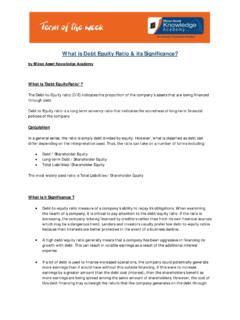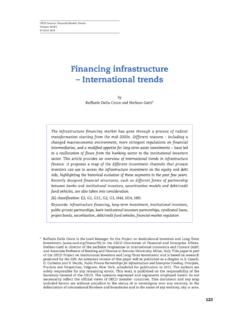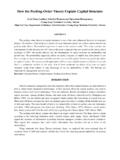Transcription of Financial Statement Analysis of Leverage and How …
1 Financial Statement Analysis of Leverage and How It Informs About Profitability and Price-to-Book Ratios Doron Nissim Graduate School of Business Columbia University 3022 Broadway, Uris Hall 604 New York, NY 10027 and Stephen H. Penman Graduate School of Business Columbia University 3022 Broadway, Uris Hall 612 New York, NY 10027 Financial Statement Analysis of Leverage and How It Informs About Profitability and Price-to-Book Ratios Abstract. This paper presents a Financial Statement Analysis that distinguishes Leverage that arises in financing activities from Leverage that arises in operations. The Analysis yields two leveraging equations, one for borrowing to finance operations and one for borrowing in the course of operations. These leveraging equations describe how the two types of Leverage affect book rates of return on equity .
2 An empirical Analysis shows that the Financial Statement Analysis explains cross-sectional differences in current and future rates of return as well as in price-to-book ratios, which are based on expected rates of return on equity . The paper therefore concludes that balance sheet line items for operating liabilities are priced differently than those dealing with financing liabilities. Accordingly, Financial Statement Analysis that distinguishes the two types of liabilities informs on future profitability and aids in the evaluation of appropriate price-to-book ratios. Keywords: financing Leverage ; operating liability Leverage ; rate of return on equity ; price-to-book ratio JEL Classification: M41, G32 1 Leverage is traditionally viewed as arising from financing activities: Firms borrow to raise cash for operations.
3 This paper shows that, for the purposes of analyzing profitability and valuing firms, two types of Leverage are relevant, one indeed arising from financing activities but another from operating activities. The paper supplies a Financial Statement Analysis of the two types of Leverage that explains differences in shareholder profitability and price-to-book ratios. The standard measure of Leverage is total liabilities to equity . However, while some liabilities -- like bank loans and bonds issued -- are due to financing , other liabilities -- like trade payables, deferred revenues, and pension liabilities -- result from transactions with suppliers, customers and employees in conducting operations. financing liabilities are typically traded in well-functioning capital markets where issuers are price takers.
4 In contrast, firms are able to add value in operations because operations involve trading in input and output markets that are less perfect than capital markets. So, with equity valuation in mind, there are a priori reasons for viewing operating liabilities differently from liabilities that arise in financing . Our research asks whether a dollar of operating liabilities on the balance sheet is priced differently from a dollar of financing liabilities. As operating and financing liabilities are components of the book value of equity , the question is equivalent to asking whether price-to-book ratios depend on the composition of book values. The price-to-book ratio is determined by the expected rate of return on the book value so, if components of book value command different price premiums, they must imply different expected rates of return on book value.
5 Accordingly, the paper also investigates whether the two types of liabilities are associated with differences in future book rates of return. Standard Financial Statement Analysis distinguishes shareholder profitability that arises from operations from that which arises from borrowing to finance operations. So, return on assets is distinguished from return on equity , with the difference attributed to Leverage . However, in the 2 standard Analysis , operating liabilities are not distinguished from financing liabilities. Therefore, to develop the specifications for the empirical Analysis , the paper presents a Financial Statement Analysis that identifies the effects of operating and financing liabilities on rates of return on book value -- and so on price-to-book ratios -- with explicit leveraging equations that explain when Leverage from each type of liability is favorable or unfavorable.
6 The empirical results in the paper show that Financial Statement Analysis that distinguishes Leverage in operations from Leverage in financing also distinguishes differences in contemporaneous and future profitability among firms. Leverage from operating liabilities typically levers profitability more than financing Leverage and has a higher frequency of favorable Accordingly, for a given total Leverage from both sources, firms with higher Leverage from operations have higher price-to-book ratios, on average. Additionally, distinction between contractual and estimated operating liabilities explains further differences in firms profitability and their price-to-book ratios. Our results are of consequence to an analyst who wishes to forecast earnings and book rates of return to value firms.
7 Those forecasts -- and valuations derived from them -- depend, we show, on the composition of liabilities. The Financial Statement Analysis of the paper, supported by the empirical results, shows how to exploit information in the balance sheet for forecasting and valuation. The paper proceeds as follows. Section 1 outlines the Financial statements Analysis that identifies the two types of Leverage and lays out expressions that tie Leverage measures to profitability. Section 2 links Leverage to equity value and price-to-book ratios. The empirical Analysis is in Section 3, with conclusions summarized in Section 4. 1. Financial Statement Analysis of Leverage 3 The following Financial Statement Analysis separates the effects of financing liabilities and operating liabilities on the profitability of shareholders equity .
8 The Analysis yields explicit leveraging equations from which the specifications for the empirical Analysis are developed. Shareholder profitability, return on common equity , is measured as equity CommonIncome Net iveComprehens(ROCEE quity Common on Return=) (1) Leverage affects both the numerator and denominator of this profitability measure. Appropriate Financial Statement Analysis disentangles the effects of Leverage . The Analysis below, which elaborates on parts of Nissim and Penman (2001), begins by identifying components of the balance sheet and income Statement that involve operating and financing activities. The profitability due to each activity is then calculated and two types of Leverage are introduced to explain both operating and financing profitability and overall shareholder profitability.
9 Distinguishing the Profitability of Operations from the Profitability of financing Activities With a focus on common equity (so that preferred equity is viewed as a Financial liability), the balance sheet equation can be restated as follows: Common equity = Operating Assets + Financial Assets - Operating Liabilities - Financial Liabilities. (2) The distinction here between operating assets (like trade receivables, inventory and property, plant and equipment) and Financial assets (the deposits and marketable securities that absorb excess cash) is made in other contexts. However, on the liability side, financing liabilities are also distinguished here from operating liabilities. Rather than treating all liabilities as financing debt, only liabilities that raise cash for operations -- like bank loans, short-term commercial paper and bonds -- are classified as such.
10 Other liabilities -- such as accounts payable, accrued 4 expenses, deferred revenue, restructuring liabilities and pension liabilities -- arise from operations. The distinction is not as simple as current versus long-term liabilities; pension liabilities, for example, are usually long-term, and short-term borrowing is a current Rearranging terms in equation (2), Common equity = (Operating Assets - Operating Liabilities) - ( Financial Liabilities - Financial Assets). Or, Common equity = Net Operating Assets - Net financing Debt. (3) This equation regroups assets and liabilities into operating and financing activities. Net operating assets are operating assets less operating liabilities. So a firm might invest in inventories, but to the extent to which the suppliers of those inventories grant credit, the net investment in inventories is reduced.
















